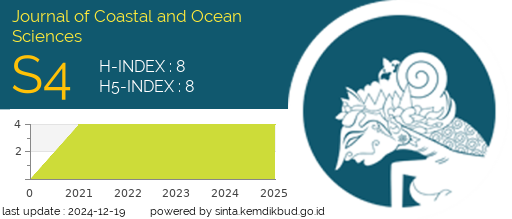Analysis of Inundation area as an Impact of Sea Level Rise in Kota Pariaman District, West Sumatera Province
DOI:
https://doi.org/10.31258/Keywords:
Sea Level Rise Inundation Kota PariamanAbstract
This research has conducted on February 2021 in Kota Pariaman District, Sumatera Barat Province. The intention of this research was to found out the sea level rise rate based on tidal data analysis from 2001-2020 and to predict the inundation area in the 20th, 50th, and 80th to go. The method of this research was a descriptive survey by using remote sensing as the additional equipment to demonstrate the outcome. The acquisition needs are primary (land use and tidal data) and secondary (slope, elevation, land use, and tidal data) data. Those parameters were processed and analyzed to describe the area of inundation by displaying a map of Kota Pariaman. Kota Pariaman territorial water has 0,44 of Formzhal number which means the waters area is classified to mixed semidiurnal tides with the sea level rise value reach out to 2,006 cm/year. Then, the number used to predict the height of sea-level rise in 20th, 50th, and 80th to go, for each is 0,471 m; 1,073 m; and 1,675m. Furthermore, the sea level rise height was analyzed to get the inundation area in 20th, 50th, and 80th to go, turns out the flooded area for each year respectively to 14,56 ha; 23,61 ha, and 38,16 ha.
Downloads
References
[IPCC] Intergovernmental Panel Climate Change. (2001). Climate change 2001: Impacts, Adaptation, And Vulnerability: Contribution of Working Group II to the third assessment report of the 74 Intergovernmental Panel on Climate Change. Cambridge University Press. Cambride.
_______. (2007). Climate Ghange Impact, Adaptation and Vulnerabilty. Cambridge University Press.
_______. (2018). Summary for Policymakers. In: Global Warming of 1.5°C. An IPCC Special Report on the impacts of global warming of 1.5°C above preindustrial levels and related global greenhouse gas emission pathways, in the context of strengthening the global response to the threat of climate change, sustainable development, and efforts to eradicate poverty [Masson-Delmotte, V., P. Zhai, H.-O. Pörtner, D. Roberts, J. Skea, P.R. Shukla, A. Pirani, Moufouma-Okia, C. Péan, R. Pidcock, S. Connors, J.B.R. Matthews, Y. Chen, X. Zhou, M.I. Gomis, E. Lonnoy, Maycock, M. Tignor, and T. Waterfield (eds.)]. World Meteorological Organization, Geneva, Switzerland, 32 pp
Akbar, F., A. Naumar, dan B. Anif. (2014). Tinjauan Perencanaan Check Dam Batang Gasan Kabupaten Padang Pariaman. Abstract of Undergraduate Research, Faculty of Civil and Planning Engineering, Bung Hatta University, 1(2).
Arsyad, S. (1989). Konservasi Tanah dan Air. Bogor : Institut Pertanian Bogor.
Azman, S. (2010). Abrasi Pantai, Kasus Kota Pariaman. Forum Masyarakat Pesisir Pariaman. Kota Pariaman.
Bratasida, L. (2002). Tinjauan Dampak Pemanasan Global dari Aspek Lingkungan Hidup. Seminar Nasional Pengaruh Global Warming terhadap Pesisir dan Pulau-Pulau Kecil ditinjau dari Kenaikan Permukaan Air Laut dan Banjir. Jakarta
Cahyaningtias. (2018). Model Spasial dan Temporal Genangan Banjir Rob Menggunakan Sistem Informasi Geografis: Studi Kasus di Pesisir Pekalongan. Thesis.
Darmawan, K., Hani'ah, dan A. Suprayogi. (2017). Analisis Tingkat Kerawanan Banjir di Kabupaten Sampang Menggunakan Metode Overlay Scoring Berbasis Sistem Informasi Geografis. Jurnal Geodesi Undip, 31-40.
Dewantara, A.H. (2015). Analisis Luas Daerah Potensi Genangan Air Rob Akibat Kenaikan Muka Air Laut Dengan Data Satelit Altimetri. Surabaya: Jurusan Teknik Geomatika. Institut Teknologi Sepuluh Nopember.
Diposaptono, S. (2009). Menyiasati Perubahan Iklim di Wilayah Pesisir dan Pulau-Pulau Kecil. Bogor: Ilmiah Populer.
Kodoatie., J. Robert dan Sugiyanto. (2002). Banjir: Beberapa Penyebab dan Metode Pengendaliannya dalam Perspektif Lingkungan. Yogyakarta: Pustaka Pelajar.
Prasetyo, Y. (2014). Analisis Optimasi dan Estimasi Penentuan Penurunan Muka Tanah menggunakan Teknik Light Permanet Scatterer Interferometric Synthetic Aperture Radar (Lpsinsar) (Studi Kasus: Cekungan Bandung). Program Studi Teknik Geodesi dan Geomatika. Institut Teknologi Bandung. Bandung.
Putra, D.R., dan M.A. Marfai. (2012). Identifikasi Dampak Banjir Genangan (Rob) terhadap Lingkungan Permukiman di Kecamatan Pademangan Jakarta Utara. Jurnal Bumi Indonesia,1(1).
Rafdi, M.A. (2016). Kajian Pemahaman Masyarakat Terhadap Perubahan Iklim di Kawasan Pesisir Kecamatan Pariaman Utara. Teknik PWK (Perencanaan Wilayah Kota), 5(1): 21-28
Samulano, I., dan M. Mera. (2011). Refraksi Dan Difraksi Gelombang Laut di Daerah Dekat Pantai Pariaman. Jurnal Rekayasa Sipil (JRS-Unand), 7(1): 1-10
Septiani, R., I Putu A.C., A.N. Sediyo. (2019). Perbandingan Metode Supervised Classification Dan Unsupervised Classification terhadap Penutup Lahan di Kabupaten Buleleng. Jurnal Geografi, 16(2):90-96.
Solihuddin, T. (2006). Karakteristik Pantai dan Potensi Bencana Geologi Pantai Bilungala, Gorontalo. Jurnal Segara, 2(1): 214-222.
______. (2011). Karakteristik Pantai dan Proses Abrasi di Pesisir Padang Pariaman, Sumatera Barat. Majalah Ilmiah Globe, 13(2).
Sukri, A. (2015). Studi Jalur Evakuasi Tsunami Horizontal di Kabupaten Padang Pariaman. Jurnal Rekayasa Sipil, 13(2), 1-12






